Students can access the CBSE Sample Papers for Class 12 Chemistry with Solutions and marking scheme Set 4 will help students in understanding the difficulty level of the exam.
CBSE Sample Papers for Class 12 Chemistry Set 4 with Solutions
Time Allowed: 3 hours
Maximum Marks: 70
General Instructions :
1. There are 33 questions in this question paper with internal choice
2. SECTION A consists of 16 multiple-choice questions carrying 1 mark each.
3. SECTION A consists of 16 multiple-choice questions carrying 1 mark each.
4. SECTION C consists of 7 short answer questions carrying 3 marks each.
5. SECTION D consists of 2 case-based questions carrying 4 marks each.
6. SECTION E consists of 3 long answer questions carrying 5 marks each.
7. All questions are compulsory.
8. Use of log tables and calculators is not allowed.
SECTION – A (16 Marks)
The following questions are multiple-choice questions with one correct answer. Each question carries 1 mark. There is no internal choice in this section.
Question 1.
When chlorine is passed through propene at 400°C, which of the following is formed?
(a) PVC
(b) Allyl chloride
(c) Vinyl chloride
(d) 1, 2-Dichloroethane
Answer:
(b) Allyl chloride
Explanation: When chlorine gas is reacted with propene at hight temperature (400°C) then substitution takes place in place of addition reaction. Hence, allyl chloride is formed.

Question 2.
Acidified potassium dichromate reacts with potassium iodide and oxidises it to I2. What is the oxidation state of chromium in the products of the reaction?
(a) +4
(b) +6
(c) +3
(d) +2
Answer:
(c) +3
Explanation: K2Cr2O7 + 7H2SO4 + 6KI → 4K2SO4 + Cr2(SO4)3 + 7Hp +3I2
We have Cr2(SO4)3 in the product in which the oxidation state of Cr is calculated as:
Let, x is the oxidation state of Cr, so,
2x + 3(- 2) = 0
X = +3
Question 3.
The magnetic moment is associated with its spin angular momentum and orbital angular momentum. Spin only magnetic moment value of Cr+3 ion is:
(a) 2.87 BM
(b) 3.87 BM
(c) 3.47 BM
(d) 3.57 BM
Answer:
(b) 3.87 BM
Explanation: Cr -> (Z = 24)
Cr+3 (Z = 21)
1s2, 2s2, 2p6, 3s2, 3p6, 3d3, 4s0
n = 3(3 impaired electrons)
\( \begin{aligned}
& \mu=\sqrt{n(n+2)}=\sqrt{3(3+2)} \\
& \mu=\sqrt{3(5)}=\sqrt{15}=3.87 \mathrm{BM}
\end{aligned}\)
![]()
Question 4.
The major product of the following reaction is:
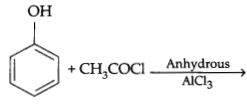

Explanation: When phenol react with CH3COCl in presence of anhydrous AlCl3 it produce ortho (minor) and para (major) product

Question 5.
What weight of glycerol should be added to 600 g of water in order to lower its freezing point by 10°C ?
(a) 496 g
(b) 297 g
(c) 310 g
(d) 426 g
Answer:
(b) 297 g
Explanation: Given that, ATf = 10°C
Now, ATf = Kf × molality
\( \begin{aligned}
10 & =1.86 \times \frac{x \times 1000}{92 \times 600} \\
x & =\frac{10 \times 600 \times 92}{1.86 \times 1000}
\end{aligned}\)
= 296.8g
Wt. of glycerol taken = 297 g
Question 6.
The reaction is spontaneous if the cell potential is :
(a) Positive
(b) Negative
(c) Zero
(d) Infinite
Answer:
(a) Positive
Explanation: Gibb’s free energy is given by
ArG = -nFEcell
For spontaneous reaction, we know
ArG = -ve
Ecell = +Ve (n, F are constant)
Question 7.
Match the Columns:
| Column I | Column II |
| 1 Colligative property | (p) Raoult’s law |
| 2 Dilute solution | (q) Osmotic pressure |
| 3 Cottrell’s | (r) Ebullioscopic constant |
| 4 Temperature | (s) Solutions having same osmotic pressure |
| 5 Isotonic solution | (t) Intensive property |
(a) 1-(p), 2-(t), 3-(r), 4-(s), 5-(q)
(b) 1-(t)y 2-(q), 3-(s), 4-(p), 5-(r)
(c) 1-(q), 2-(p), 3-(r), 4-(t), 5-(s)
(d) 1-(r),2-(t),3-(q),4-(s),5-(p)
Answer:
(c) 1-(q), 2-(p), 3-(r), 4-(t), 5-(s)
Explanation: Osmotic pressure is colligative property, dilute solution obeys Raoult’s law, Cottrell’s method uses ebullioscopic constant, temperature is an intensive property and isotonic solutions are solutions having same osmotic pressure.
![]()
Question 8.
Rate law for the reaction A + 2B → C is found to be:
Rate = k [A] [B]
The concentration of reactant ‘B’ is doubled, keeping the concentration of ‘A’ constant, the value of rate constant will be______________.
(a) The same
(b) Doubled
(c) Quadrupled
(d) Halved
Answer:
(b) Doubled
Explanation: The rate concentration of a reaction does not depend upon concentration of the reactions. Hence, it will remain the same. Even if the equation shows the double concentration level the rate concentration doubles so it is the same throughout.
Following with the equation A + 2B → C
If rate considered as (1) Rate1 = k [A][B]
If rate considered as 2
Then, Rate1 = k [A][2B]
Rate2 = 2 Rate1
Hence, the value of rate constant will be doubled.
Question 9.
The given graph shows the vapour pressure-temperature curves for some liquids.

Liquids A, B, C and D respectively are,
(a) Ethyl alcohol, acetone, diethyl ether, water
(b) Water, ethyl alcohol, acetone, diethyl ether
(c) Acetone, ethyl alcohol, diethyl ether, water
(d) Diethyl ether, acetone, ethyl alcohol, water
Answer:
(d) Diethyl ether, acetone, ethyl alcohol, water
Explanation: The vapour pressure increases with decrease in intermolecular forces and increase in temperature. As when temperature increases the molecular forces are weakend and bonds are broken between molecules. When the forces are weak, the liquid has high volatility and maximum vapour pressure. Diethyl ether has highest vapour pressure while water has lowest vapour pressure.
Question 10.
If 96500 coulomb electricity is passed through CuSO4 solution, it will liberate:
(a) 63.5 g of Cu
(b) 31.76 g of Cu
(c) 96500 g of Cu
(d) 100 g of Cu
Answer:
(b) 31.76 g of Cu
Explanation: At cathode: Cu2+(aq) + 2e– → Cu(s)
At anode: 4OH–(aq) → 2H2O(Z) + O2(g) + 4e–
Faraday’s constant = 96500 C/mol
To deposite1 mole of copper, we need 2 × 96500 C.
So, 96500 C will deposite 0.5 moles of copper = 0.5 × 63.5 = 31.75 g.
Hence, 31.76 gm of Cu will be liberated.
Question 11.
Transition metals, when theyforminterstitial compounds, the non – metals (H, B, C, N) are accommodated in :
(a) Voids or holes in cubic-packed structure
(b) Tetrahedral voids
(c) Octahedral voids
(d) All of these
Answer:
(d) All of these
Explanation: Transition metals have defects in their crystal lattice. The transition metals form interstitial compounds as small atoms like C, H or N are trapped inside the interstitial spaces in the crystal lattice of metals. Hence, transition metals, when they form interstial compounds, the nonmetals are accommodated in voids.
Question 12.
Which one of the following reducing agents is likely to be most effective in bringing about the following change?

(a) H2– Ni
(b) NaBH4
(c) LiAlH4 ether
(d) Na-Alcohol
Answer:
(c) LiAlH4 ether
Explanation: The given reaction is the reduction of primary amides in the presence of the reducing agent LiAlH4 to primary amines.
![]()
Question No.13 to16 consist of two statements- Assertion (A) and Reason (R). Answer these questions selecting the appropriate option given below:
(a) Both A and R are true and R is the correct explanation of A.
(b) Both A and R are true but R is not the correct explanation of A.
(c) A is true, but R is false.
(d) A is false, but R is true.
Question 13.
Assertion (A): It is not always convenient to determine the instantaneous rate.
Reason (R): Instantaneous rate is measured by the determination of slope of the tangent at point ‘t’ in concentration versus time plot.
Answer:
(a) Both A and R are true and R is the correct explanation of A.
Explanation: It is not always convenient to determine the instantaneous rate, as it is measured by determining the slope of the tangent at point Y in concentration Vs time plot. This generally makes it difficult to determine the rate law and hence, the order of the reaction. Hence, both assertion and reason are true and reason is the correct explanation of assertion.
![]()
Question 14.
Assertion (A): Ethanol is a weaker acid than phenol.
Reason (R): Sodium ethoxide may be prepared by the reaction of ethanol with aqueous NaOH.
Answer:
(c) A is true, but R is false.
Explanation: Phenol is stronger acid than ethanol as phenoxide ion is stabilized by resonance whereas no such stabilization occurs in ethoxide ion. Sodium ethoxide can be prepared by reaction of ethanol with sodium. Thus, assertion is true but reason is false.
Question 15.
Assertion (A): When NaCl is added to water a depression in freezing point is observed.
Reason (R): The lowering of vapour pressure of a solution causes no depression in the freezing point.
Answer:
(c) A is true, but R is false.
Explanation: When NaCl is added to water a depression in freezing point is observed. This is due to lowering of vapour pressure of a solution. Thus, assertion is true but reason is false.
Question 16.
Assertion (A): To obtain maximum work from a galvanic cell, charge has to be passed reversibly.
Reason (R): The reversible work done by a galvanic cell is equal to decrease in its Gibbs energy.
Answer:
(a) Both A and R are true and R is the correct explanation of A.
Explanation: Electrical work done in one second is equal to electrical potential multiplied by total charge. If we want to obtain maximum work from a galvanic cell then charge has to be passed reversibly. The reversible work done by a galvanic cell is equal to decrease in its Gibbs energy and therefore, if the emf of cell is E and nF is the amount of charge passed and ΔG is the Gibbs energy of reaction then, ΔG = – nFEcell
Thus, both assertion and reason are correct and reason is the correct explanation of assertion.
SECTION – B (10 Marks)
This section contains 5 questions with internal choice in one questions. One following questions are very short answer type and carry 2 marks each.
Question 17.
Why do primary amines have higher boiling point than tertiary amines?
Answer:
In a molecule of tertiary amine, there are no H-atoms whereas in primary amines, two hydrogen atoms are present. Due to the presence of H-atoms, primary amines undergo extensive intermolecular H-bonding. In a molecule of tertiary amine, there are no H-atoms whereas in primary amines, two hydrogen atoms are present. Due to the presence of H-atoms, primary amines undergo extensive intermolecular H-bonding.

As a result, extra energy is required to separate the molecules of primary amines. Hence, primary amines have higher boiling points than tertiary amines.
Question 18.
For the reaction: 2A + B → A2B
the rate = k[A][B]2 with k = 2.0 × 10-6 mol-2 L2s-1. Calculate the initial rate of the reaction when [A] = 0.1 mol L-1, [B] = 0.2 mol L-1. Calculate the rate of reaction after [A] is reduced to 0.06 mol L-1.
Answer:
The initial rate of the reaction is Rate = k[A][B]2
= (2.0 × 10-6 mol-2 L2s-1) (0.1 mol L-1) (0.2 mol L-1)2
= 8.0 × 10-9 mol L-1 s-1
When [A] is reduced from 0.1 mol L-1 to 0.06 mol L-1, the concentration of [A] reacted
= (0.1 – 0.06) mol L-1 = 0.04 mol L-1
Therefore, concentration of [B] reacted = 1/2 × 0.04 mol L-1 = 0.02 mol L-1.
As [B] used in reaction is 1/2 moles per 1 mole of A.
Then, concentration of [B] available, [B] = (0.2 – 0.02) mol L-1.
= 0.18 mol L-1
After [A] is reduced to 0.06 mol L-1, the rate of the reaction is given by,
Rate = k[A][B]2
= (2.0 × 10-6 mol-2 L2 s-1) (0.06 mol L-1) (0.18 mol L-1)2
= 3.89 × 10-9 mol L-1 s-1.
Question 19.
Write the IUPAC name of the following compounds:

Answer:
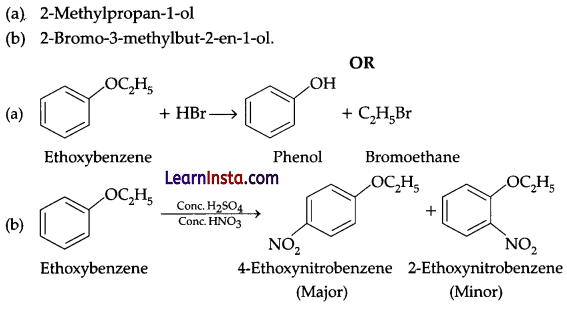
Question 20.
(a) How is glucose obtained commercially?
(b) Which carbonyl group is present in the structure of glucose?
Answer:
(a) Glucose is obtained commercially by hydrolysis of starch by boiling it with dilute H2SO4 at 393 K under pressure of 2-3 atm.

(b) Aldehyde group is present in the structure of glucose.
Question 21.
(a) Write the IUPAC name of following coordination compounds :
1. [CO(H2NCH2CH2NH2)3]2(SO4)3
2. Hg[Co(SCN)4]
(b) Mention the type of hybridisation usually associated with following geometries :
1. Trigonal bipyramidal
2. Square planar
Answer:
(a) 1. Tris(ethane-1, 2-diamine) cobalt(III) sulphate
2. Mercury(I) tetrathiocyanatocobaltate(III)
(b) 1. Trigonal bipyramidal- sp3d
2. Square planar- dsp2
SECTION – C (21 Marks)
This section contains 7 questions with internal choice in one questions. The following questions are short answer type and carry 3 marks each.

![]()
Question 23.
The reaction between A and B is first order with respect to A and zero order with respect to B. Fill in the blanks in the following table:
| Experiment | A (Mol L-1) | B (Mol L-1) | Initial rate (mol L-1 min-1) |
| I | 0.1 | 0.1 | 2.0 x 10- 2 |
| II | ….. | 0.2 | 4.0 x 10-2 |
| III | 0.4 | 0.4 | …… |
| IV | ….. | 0.2 | 2.0 x 10-2 |
Answer:
The given reaction is of the first order with respect to A and of zero order with respect to B.
Therefore, the rate of the reaction is given by,
Rate = k[A]1[B]0
⇒ Rate = k[A]
From experiment I, we obtain
2.0 × 10-2 mol L-1 min-1 = k(0.1 mol L-1)
⇒ k = 0.2 min-1
From experiment II, we obtain
4.0 × 10-2 mol L-1 min-1 = 0.2 min-1 [A]
⇒ [A] = 0.2 mol L-1
From experiment III, we obtain
Rate = 0.2 min-1 × 0.4 mol L-1
⇒ = 0.08 mol L-1 min-1
From experiment IV, we obtain
2.0 × 10-10 mol L-1 min-1 = 0.2 min-1 [A]
[A] = 0.1 mol L-1
Question 24.
(a) The standard electrode potential (E°) for the cell containing 0.1 M Ag+ and 4.00 M Cu2+ at 298 K are E°Cu2+/Cu = + 0.34 V, E°Ag+/Ag as = + 0.80 V Calculate the cell potential (E).
(b) How many hours does it take to reduce 3 mol of Fe3+ to Fe2+ with 2.00 A current? [R = 8.314 JK-1 mol-1,1 F = 96500 C]
Answer:
(a) Cell reaction,
Cu(s) + 2Ag+(aq) → 2Ag(s) + Cu2+(aq)
n = 2
Using Nemst equation,
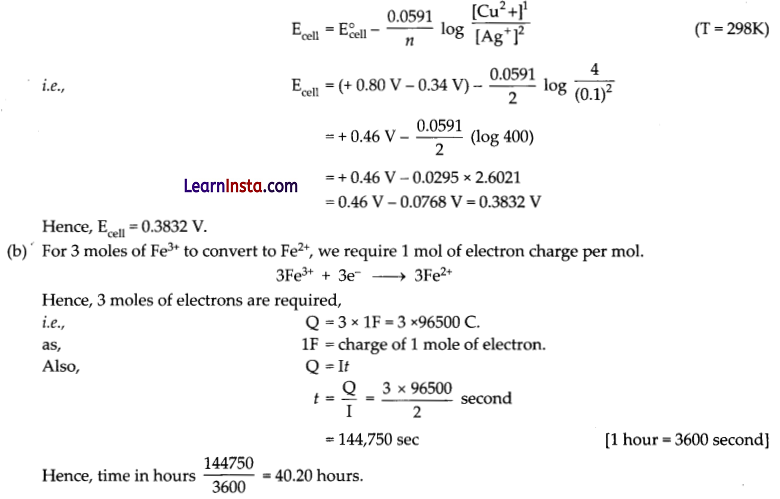
Question 25.
Attempt any two:
(a) Arrange the following in the increasing order of acidic strength :
M-butanol, 2-methylpropan-l-ol, 2-methylpropan-2-ol
(b) Give a chemical test to distinguish between propanol and 2-methylpropan-2-ol.
(c) Predict the products :

Answer:
(a) As the alkyl group increase the electron density attached to the carbon bearing the oxygen atom, they destabilise the anion formed after loosing proton. Hence, the acidic strength will vary in below order.
2- methylpropan-2-ol < 2-methylpropan-l-ol < n-butano
(b) Lucas Test in alcohol is a test used to differentiate between Primary, Secondary and Tertiary alcohols. This test is carried out with the help of Lucas reagent, which is a solution of anhydrous ZnCl2 and cone. HCl.
In case of tertiary alcohols, instantaneous turbidity appears in the solution while in secondary alcohols turbidity appears after 4-5 minutes. Therefore, propanol and 2-methylpropan-2-ol can be distinguished using by Luca’s reagent, (ZnCl2 + HCl) solution. 2-methylpropan-2-olreact immediately at room temperature to give a white precipitate of corresponding alkyl chloride, whereas in case of propanol turbidity appears after heating.

Question 26.
An aqueous solution freezes at 272.4 K while pure water freezes at 273.0 K. Determine :
(a) The molality of the solution.
(b) Boiling point of the solution.
Given : Kf water = 1.86 K kg mol-1, Kb = 0.512 K kg mol-1
Answer:
(a) As depression of freezing point (ΔTf) is directly proportional to molality of solution :
ΔTf = Kfm
Now putting the values :
m = ΔTf/Kf
m = \(\frac{273.0 \mathrm{~K}-272.4 \mathrm{~K}}{1.86 \mathrm{~K} \mathrm{~kg} \mathrm{~mol}^{-1}}\) = 0.323 mol kg-1
(b) Similarly, ΔTb =Kbm
= 0.323 mol kg-1 × 0.512 K kg mol-1 = 0.165 K
As, boiling point of water is 373.15 K, therefore boiling point of solution would be:
373.15 K + 0.165 K = 373.31 K
![]()
Question 27.
An organic compound [A] having molecular formula C3H6O, gives iodoform reaction and forms a compound [B]. [B] on heating with Ag powder, gives compound [C]. [C] reacts with dil. H2SO4 and mercuric sulphate to obtain compound [D], Compound [D] undergoes Aldol condensation. Write
down the names and structures of all the compounds starting from [A] to [D] with the help of chemical equations.
Answer:
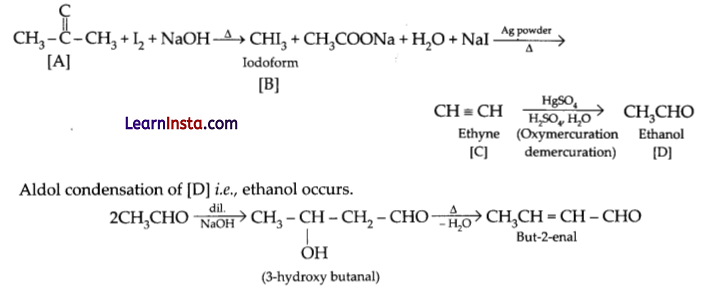
Question 28.
Depict the galvanic cell in which the reaction
Zn(s) + 2Ag+(aq) → Zn2+(aq) + 2Ag(s) takes place. Further show:
(a) Which electrode is negatively charged?
(b) The carriers of the current in the cell.
(c) Individual reaction at each electrode.
Answer:
The galvanic cell in which the given reaction takes place is depicted as:
Zn(s) | Zn+2(Ag) || Ag+(aq) | Ag(s)
(a) Zn electrode (anode) is negatively charged.
(b) Ions are carriers of current in the cell and in the external circuit, current will flow from silver to zinc. Ions are Zn2+ and Ag+.
(c) The reaction taking place at the anode is given by,
Zn(s) → Zn2+(aq) + 2e–
The reaction taking place at the cathode is given by,
Ag+(aq) + e– → Ag(s)
SECTION – D (8 Marks)
The following questions are case-based questions. Each question has an internal choice and carries 4 (1+1+2) marks each. Read the passage carefully and answer the questions that follow.
Question 29.
In modem periodic table, d-block elements are called transition metals since their properties are intermediate between those of s and p-block elements having their general electronic configuration (n – 1)d1-10 ns1-2. In transition elements the valence electron are present in outermost shell as well as d-orbital of the penultimate shell. The oxidation elements differ from each other by unity and they show oxidation state +1 to +7. In the first series of transition elements Cu exhibits +1 oxidation state most frequently.
(a) Which d-block elements are not normally considered as transition elements?
(b) In which orbital last e~ is filled in transition element?
(c) Why oxidation states of transition element differ from each other by unity?
OR
Which transition elements show high oxidation state?
Answer:
(a) Zn, Cd, Hg (due to d10 configuration).
(b) Penultionate d-orbital i.e., (n- 1) d-orbital.
(c) Due to incomplete filling of d-orbital, oxidation states vary.
OR
Mn, + 7.
Question 30.
Solvolysis, is a chemical reaction in which the solvent, such as water or alcohol, is one of the reagents and is present in great excess of that required for the reaction. Solvolytic reactions.are usually substitution reactions i.e., reactions in which an atom or a group of atoms in a molecule is replaced by another atom or group of atoms. The solvents act as or produce electron-rich atoms or groups of atoms (nucleophiles) that displace an atom or group in the substrate molecule. At high temperatures or in the presence of strong bases, some solvents act as eliminating agents, producing alkenes from alkyl halides. It is common practice to name solvolysis reactions after the specific solvent, such as “hydrolysis” when water is the reagent.

Answer the following questions:
(a) The above-mentioned solvolysis is SN1 or SN2 type reaction?
(b) What is reason for the difference in solvolysis reaction?
(c) Why the compound (A) undergoes a solvolysis reaction?
OR
Why the compound (B) does not undergo solvolysis reaction?
Answer:
(a) SN1 type reaction.
(b) Difference in solvolysis reaction is due to the stability of carbocation formed during the course of reaction.
(c) The carbocation obtained from C- Cl bond cleavage of the compound (A) is a very stable aromatic compound [cyclopropenyl cation having (4n + 2)n electrons, where n = 0].
For this reason, the compound (A) undergoes solvolysis (SN1) at a faster rate.

OR
The carbocation expected to be obtained on C – Cl bond cleavage of ‘B’ in an unstable anti-aromatic carbocation [cyclopentadienyl cation, having 4nn electrons, where n =1], There, the compound ‘B’ does not undergo solvolysis (SN1) in ethanol.

SECTION – E (15 Marks)
The following questions are long answer type and carry 5 marks each. All questions have an internal choice.
Question 31.
Write the various reactions of glucose and justify your answer based on its structure Attempt any five of the following:
(a) Glucose forms mono glucoxime.
(b) Glucose contains 6-carbon chain.
(c) Glucose forms pentaacetate, but not hexacetate.
(d) Glucose pentaacetate does not reacts with NH2OH
(e) Glucose does not give positive Schiff ‘s test or NaHSO3 addition product in spite of having an aldehyde group.
(f) Hydrolytic product of lactose.
(g) Pyranose ring of glucose.
Answer:
(a) Due to the presence of a single carbonyl group glucose forms glucoxime.

(d) The aldehydic group is absent in the a-D-glucose pentaacetate or p-D-glucose pentaacetate. It is involved in the cyclic bond between first and the 5th carbon of the chain. Hence, glucose pentaacetate does not give any reaction with NH2OH.
(e) The open chain form of glucose is responsible for the positive tests of aldehyde given by glucose. But in case of Schiff’s reagent and NaHSO3 which are weak reagents, the reactions are reversible and the equilibrium cannot be shifted to get more and more open chain form, which is smaller in amount in the mixture of a and P cyclic glucose forms.
(f) Lactose is a disaccharide composed of p-D-galactose and P-D-glucose. Thus, on hydrolysis, it gives P-D-galactose and P-D-glucose.
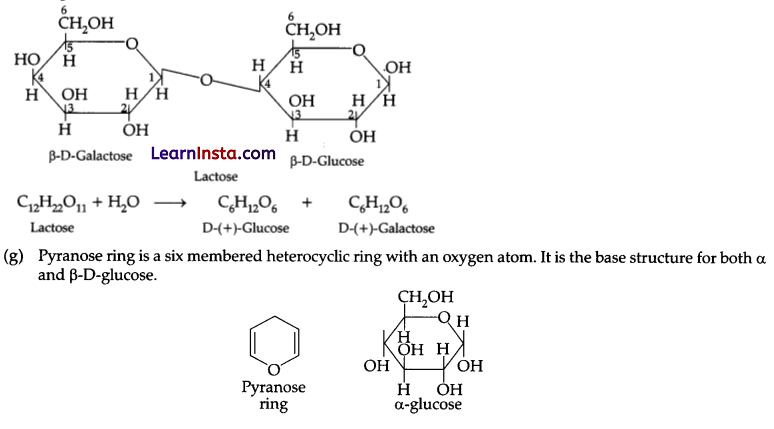
![]()
Question 32.
Discuss the nature of bonding in the following coordination entities on the basis of valence bond theory.
(a) [FeCN)6)]4-
(b) [FeF6]3-
(c) [Co(C2O4)3]3-
(d) [CoF6]3-
OR
Using valence bond theory, explain the following for the complexes given below:
[Mn(CN)6]3-, [CO(NH3)6]3+, [FeCl6]4-.
(a) Type of hybridisation
(b) Geometry
(c) Magnetic behavior
(d) Inner or outer orbital complex
(e) Spin only magnetic moment value.
Answer:
(a) [FeCN)6)]4-
In the above coordination complex, iron exists in the +2 oxidation state.
Fe2+ : Electronic configuration is 3d6 orbitals of Fe2+ ion




OR
[Mn(CN)6]3- oxidation state of Mn is (+3)
[CO(NH3)6]3+ oxidation state of Co is (+3)
[FeCl6]4- oxidation state of Fe is (+ 2)
In [Mn(CN)6]3-, CN is a strong field ligand.
In [CO(NH3)6]3+, NH3 is a weak field ligand.
In [FeCl6]4-, Cl- is a weak field ligand.
Now [Mn(CN)6]3-; Mn3+(3d4).

(a) Hybridisation sp3d2.
(b) Octahedral
(c) Paramagnetic
(d) Outer orbital complex
(e) \( \begin{aligned}
\mu & =\sqrt{n(n+2)}=\sqrt{4(4+2)} \\
& =\sqrt{24}=4.9 \mathrm{BM}
\end{aligned}\)
Question 33.
An Organic compound A (C7H6Cl2) on treatment with NaOH solution gives another compound B (C7H6O). B on oxidation gives an acid C(C7H6O2) which on treatment with a mixture of cone. HNO3 and H2SO4 gives compound D (C7H5NO4). B on treatment with cone. NaOH gives a compound E (C7H8O) and C6H5COONa. Deduce the structures of [A], [B], [C], [D] and [E].
OR
(a) Account for the following:
(i) p-Nitrobenzoic acid has higher Ka than benzoic acid.
(ii) Carboxylic adds have higher boiling points than alcohols.
(iii) Acetone is soluble in water but benzophenone is not.
(b) (i) Out of CH3CH2COCH2CH3 and CH3CH2CH2COCH3 which gives positive iodoform test? Why?
(ii) Arrange the following esters in decreasing order of alkaline hydrolysis. Justify your arrangement.

Answer:

OR
(a) (i) Nitro group is an electron withdrawing group. Hence, its presence in para position makes the release of H+ ion from benzoic acid easier than unsubstituted benzoic acid. Hence p-Nitrobenzoic acid is more acidic and have higher Ka value.
(ii) The extent of hydrogen bonding in carboxylic acids is far more than alcohols. The OH bond of -(COOH) group is far more polarized than OH bond of alcohols; because of presence of electron withdrawing carbonyl group. Additional H-bonds are also formed by the negatively charged oxygen atom of carbonyl carbon with a positively charged hydrogen of some adjacent molecule.

hindered by two big phenyl group (C6H5COC6H5), hence the carbonyl oxygen is masked and cannot participate in hydrogen bonding with water.
(b) (i) Iodoform test is given by compound containing a methyl ketone group i.e., CH3CH3CH2COCH3 will give positive iodoform test.
(ii) The rate of hydrolysis depends on the electron deficiency of the carbonyl carbon of the ester group. Hence presence of electron withdrawing groups increases the rate of reaction whereas electron donating group decreases the rate of hydrolysis. Hence the decreasing order of rate for the given esters is.

Must Read: